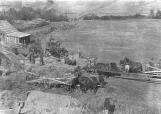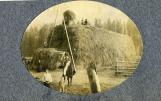1
J.R. Jackson and Robert "Sonny" Jackson: harvest time on the Jackson RanchCirca 1910
The Kettle River Valley
 Credits:
Credits:Kettle River Museum
Donated by Nora Eveleth, 1979
2
"Machinery in earlier days was not very plentiful, so farmers helped their neighbours and were helped in return in the use of a machine that would be too expensive for each to own. When grain crops were good, the local thresherman would be hard pressed to get the jobs done before snowfly..."- from "A Harvest of Memories" by Bill Hatton, 1985
3
Threshing on the McMynn Ranch in Myncaster1912
Benchlands of the Kettle River Valley
 Credits:
Credits:Kettle River Museum
Donated by Ron Roylance, 2004
4
"Threshing grain in the fall was a primitive operation requiring a dozen men and many teams of horses. A nearby neighbour owned a small grain separator, which he operated by jacking a wheel of his old car up and belting it to the separator. A few of the local thresher men used steam traction engines, which were not powerful enough to haul the threshing rig around these steep hills, so a four-horse team was used to pull the thresher. The team was also used on a water wagon to keep the steam engine supplied."- from "A Harvest of Memories" by Bill Hatton, 1985
5
Haying at Art LandersCirca 1915
Benchlands of the Kettle River Valley
 Credits:
Credits:Kettle River Museum
Donated by William Moll, 1978
6
Haying at the Jackson Ranch1905
The Kettle River Valley
 Credits:
Credits:Kettle River Museum
Donated by Nora Eveleth, 1978
7
"In early days hay was put up loose. The three-tined pitchfork was the most important piece of machinery, and when the hay was raked into windrows, it was piled into haycocks to cure until ready to haul to the stack or barn. The hay was drawn by teams to the stack and lifted from the wagons by a hayfork which was pressed down into the load and locked. The load was then pulled up by a derrick team to the high line through a series of pulleys. There were four poles, two at each end of the stack with the high line to carry the hay along and to be released where the stacker wanted it dumped.A similar method of operation was used in filling the hay barns, with an open end near the top for a sling or fork load of hay to enter and be carried along on a track in the peak of the building."
- from "A Harvest of Memories" by Bill Hatton, 1985"
8
Threshing up at the Weed RanchCirca 1915
Benchlands of the Kettle River Valley
 Credits:
Credits:Kettle River Museum
9
Threshing up at the Weed RanchCirca 1915
Benchlands of the Kettle River Valley
 Credits:
Credits:Kettle River Museum
Donated by William Moll, 1978
10
"My initiation into the threshing of grain was an unforgettable experience. The greenhorn was delegated to build the straw pile, and to try to keep the walls straight. He would direct the man at the thresher where he would want the straw blown. If there is a dirtier, dustier job, I have never seen or heard of it! No wonder men soon learned to be proficient in other work around the threshing machine.It was the custom to sack the grain as it came from the machine, and either haul it to the granary or leave it piled in the field for sale later on. I became a sack-sewer. Anything to get away from being a strawpiler!"
- from "A Harvest of Memories" by Bill Hatton, 1985
11
Threshing up at the Weed RanchCirca 1915
Benchlands of the Kettle River Valley
 Credits:
Credits:Kettle River Museum
Donated by William Moll, 1978
12
Old style haying on the Jackson RanchCirca 1910
The Kettle River Valley
 Credits:
Credits:Kettle River Museum, Sonny Jackson collection
Donated by the estate of Mike Downing, 1977
13
Down by the Kettle River on the Jackson RanchCirca 1910
The Kettle River Valley
 Credits:
Credits:Kettle River Museum
14
"Our land in the Bridesville area is suitable for raising all the grains, hay and vegetables. Hay was stacked in the fields at haying time and any surplus over the farm requirements was baled later in the fall or early winter when there was more time. The baler was powered by a team of horses, who walked around in a circle, and were attached to a pole that was geared to the baler. A good day's output was ten to twelve tons of hay with a crew of seven men."- from "A Harvest of Memories" by Bill Hatton, 1985